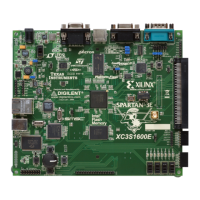
Do you have a question about the Xilinx MIcroBlaze Development Spartan-3E 1600E Kit and is the answer not in the manual?
| FPGA Device | XC3S1600E |
|---|---|
| FPGA Family | Spartan-3E |
| Ethernet | 10/100 Ethernet PHY |
| USB | USB 2.0 |
| System Gates | 1600000 |
| Configuration | JTAG |
| Connectors | VGA, RS-232, PS/2, Audio |
| Clocking | 50 MHz oscillator |
| Development Tools | Xilinx ISE |
| Power Supply | 5V |
| Operating Temperature | 0°C to +85°C |
Highlights features of the Spartan-3E FPGA for embedded processing.
Lists the main hardware components and capabilities of the development kit.
Details jumper settings for selecting FPGA configuration modes.
Guides on programming devices using the USB interface and iMPACT.
Instructions for connecting the USB Type A/Type B cable.
Steps for downloading designs using the iMPACT software.
Procedure for programming the Platform Flash PROM.
Process for creating the FPGA bitstream file.
Steps to generate a PROM file using iMPACT.
Details on programming the Platform Flash PROM.
Details the LCD controller IC and its memory regions.
Summarizes available LCD controller commands and bit definitions.
Details how to operate the character LCD.
Explains the 4-bit data interface used for the LCD.
Provides the sequence for initializing the LCD after power-on.
Explains how to write data to the LCD.
Details VGA timing signals for a 60 Hz, 640x480 display.
Explains VGA timing parameters and their relation.
Details PS/2 keyboard communication protocols and scan codes.
Explains PS/2 mouse communication and coordinate system.
Details the Serial Peripheral Interface (SPI) for DAC communication.
Describes the SPI communication protocol for the DAC.
Explains how to calculate DAC output voltage.
Details conversion of analog inputs to digital representation.
Describes the programmable gain amplifier for signal scaling.
Details the programmable gain settings for the amplifier.
Details the two-channel ADC and its sampling process.
Explains the SPI bus transaction for ADC control.
Details the connections between the FPGA and the StrataFlash device.
Guides on configuring the FPGA from SPI Flash.
Details how to set mode pins for SPI configuration mode.
Steps to format an FPGA bitstream for SPI Serial Flash.
Procedure for formatting a PROM file for SPI Flash.
Methods for programming the SPI Flash.
Detailed steps for downloading SPI Flash using XSPI utility.
Instructions for obtaining and installing the XSPI utility.
Guides on connecting JTAG cables for programming.
Details the connections between the FPGA and the DDR SDRAM.
Details the FPGA connections to the Ethernet PHY via MII.
Describes the Ethernet MAC IP cores for MicroBlaze applications.
Details the 100-pin FX2 edge connector and its features.
Explains the voltage sources provided to the FX2 connector.
Shows the pinout and FPGA connections for the FX2 connector.
Explains options for differential input termination.
Details voltage requirements for differential outputs.
Schematics for FPGA config, flash memory, and JTAG connections.